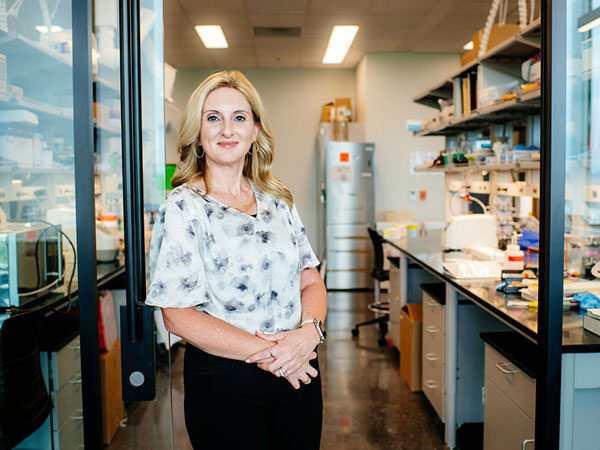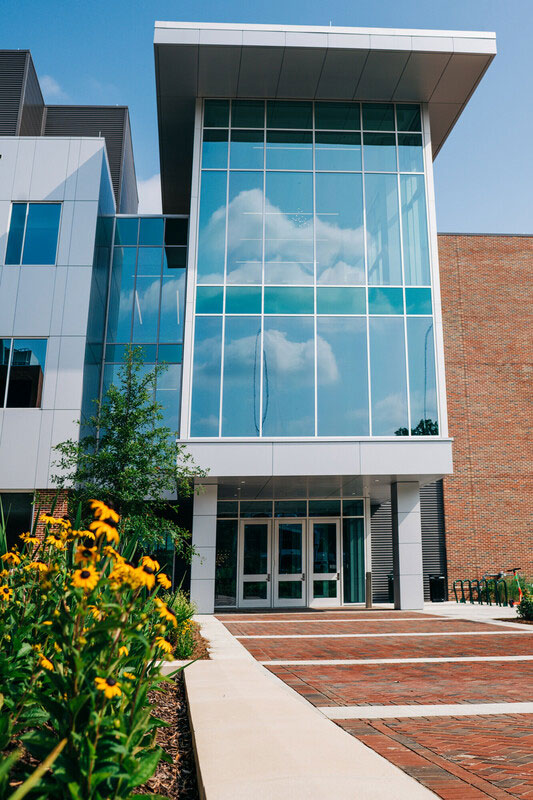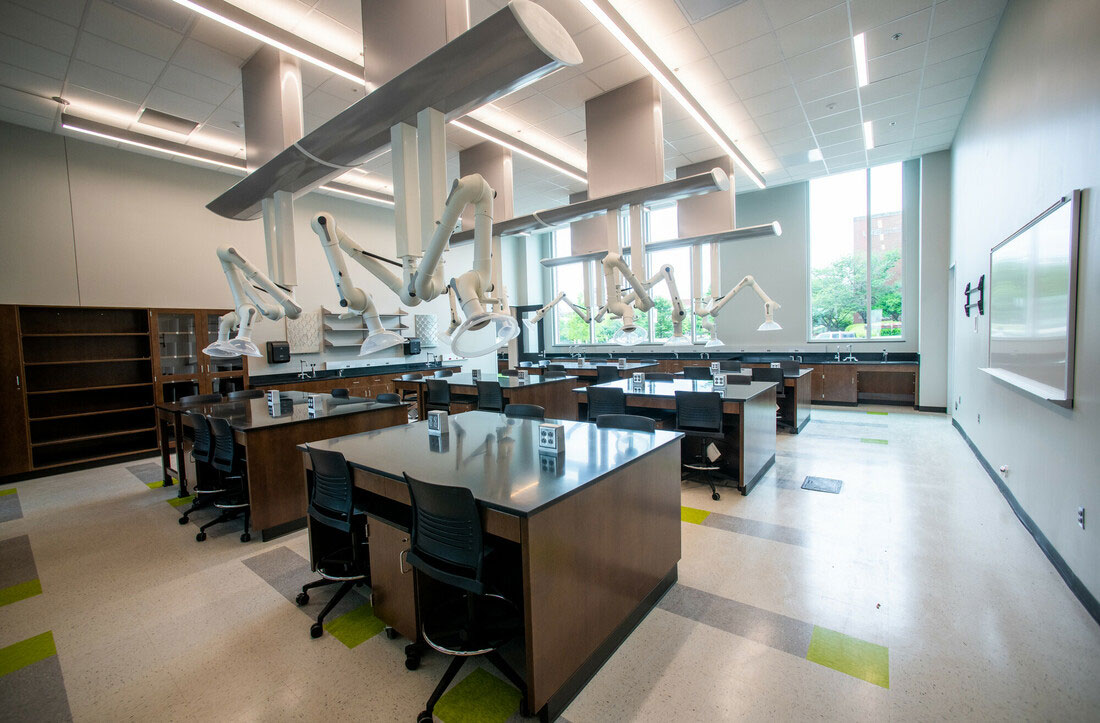 Karolina M. Mukhtar, professor and Chair of Department of Biology
Karolina M. Mukhtar, professor and Chair of Department of Biology
For more than a year, whenever University of Alabama at Birmingham Ph.D. student Marcelo Barreto Filho headed home from the Department of Biology in Campbell Hall, he caught a gleaming glimpse of the future that made him smile. That’s because Barreto Filho’s path allowed him to watch the construction progress of the UAB Science and Engineering Complex, which will be the Department of Biology’s new home beginning this fall.
“Every time I go by it, I think, ‘Wow, I can’t believe I’m going to be working in that building.’ Because it’s so beautiful,” Barreto Filho said. “It’s going to be a great addition to the Biology Department. Not just in terms of the research, but also in terms of what other people think about us when they see that building.”
The building’s completion is a moment that new Department of Biology chair Karolina Mukhtar, Ph.D., has eagerly awaited since 2018, when as an associate chair she was chosen to be part of the building’s planning committee. Five years later, renderings have become reality, and Mukhtar gets to start her new role in a shiny new space.
“Most chair positions don’t come with the opportunity to move into a new building and get that state-of-the-art space for research and teaching,” Mukhtar said. “I’ve watched the building grow from scratch, and I couldn’t be happier to now be able to move into it and deploy the operations that we envisioned back in 2018. It will help us in so many ways.
 Exterior entrance of Phase I of the new Science and Engineering Complex showing black-eyed Susan flowers blooming in Sterne Plaza.“These are exciting times for us, because there is new leadership and a new building all at the same time. The excitement and energy are through the roof.”
Exterior entrance of Phase I of the new Science and Engineering Complex showing black-eyed Susan flowers blooming in Sterne Plaza.“These are exciting times for us, because there is new leadership and a new building all at the same time. The excitement and energy are through the roof.”
In this case, that roof is housing modern equipment as well as collaborative work areas that Mukhtar said will enhance the department’s teaching and research capabilities. For example, because of limited lab facilities, Mukhtar said the department’s Course-based Undergraduate Research Experience (CURE) offerings have been restricted to only biology honors students. In the new building, they will be open to any student taking a biology course.
“Now we’ll be able to do more teaching through research, which is one of the big bragging points of the building,” Mukhtar said. “This will help the students grow, and not just perform everything step-by-step through instructions. It will be a more open-ended investigation, where you don’t necessarily know what you will discover in the end. But the scientific process that students learn will then be taken to future courses and eventually their career.
“It’s a priority for the state to train more STEM workforce. In the new building, students will have access to lab opportunities that will allow us to take the quality of STEM instruction to the next level. There is so much potential locked into some students who never got a chance in high school to see this type of process. Now that they will be given the opportunity, they can bloom and become a person they never thought they could be. This is going to be a huge game-changer.”
Faculty and research members will benefit as well, particularly when it comes to the open design space that allows for easier collaboration. Mukhtar said the Biology Department’s entire research operation will move into two large labs, each capable of accommodating approximately 60 people.
“That was a deliberate move when the building was being designed, to promote collaboration,” Mukhtar said. “Our offices have always been scattered on different floors of (Campbell Hall). Now we’ll be in a suite where we will all be together. You see a colleague and you strike up a conversation. That’s important, because science is becoming increasingly collaborative.”
UAB associate professor Nicole Riddle, Ph.D., agreed. Riddle is the principal investigator on a five-year, $12.5 million grant from the National Sciences Foundation to form the IISAGE Biology Integration Institute, with a goal of determining how various biological mechanisms and pathways contribute to differences in aging between females and males. Riddle said it is the type of research work that benefits from an influx of fresh ideas and suggestions.
 Interior of new Science and Engineering Complex showing a laboratory equipped with exhaust snorkel dome hoods at each station.“The physical separateness we’ve had meant that it took effort to collaborate,” Riddle said. “But now we’ll all be in one room, which will really facilitate us talking to each other more. Even just having those informal conversations can be really important for science.
Interior of new Science and Engineering Complex showing a laboratory equipped with exhaust snorkel dome hoods at each station.“The physical separateness we’ve had meant that it took effort to collaborate,” Riddle said. “But now we’ll all be in one room, which will really facilitate us talking to each other more. Even just having those informal conversations can be really important for science.
“You hear about new techniques, and that broadens your perspective. It basically opens up a whole new world of conversations. That’s especially important for our trainees, because they’re still learning and trying to find their place in science.”
In addition to internal collaboration, Mukhtar said the building also will promote increased partnerships between the Department of Biology and the Department of Physics, which is making the move as well.
“We’ve been housed with physics (in Campbell Hall), but the way the spaces are designed, we barely see each other,” Mukhtar said. “We haven’t collaborated as much, which is a shame. We should be working together more closely. The whole idea of making it a science and engineering complex was to bring in all the key stakeholders and almost force them to collaborate.
“When two scientists start talking, it doesn’t take long for them to find a convergence point that they can start building from. This is exactly the kind of collaboration we want to see happening in the new building. If they start having those scientific conversations, then maybe they’ll start working together, and we can be more of a team.”
Mukhtar said the new building also can help foster partnerships outside of the College of Arts and Sciences. She said one of her goals is to develop a joint degree with the UAB Collat School of Business combining biology with entrepreneurship, so graduates will gain both scientific knowledge and the skills needed to start a company.
And because the building is so aesthetically pleasing, with plenty of windows and natural light, Mukhtar said it will be an ideal location to hold events and gatherings with biotech companies and others in the local business community.
“The biotech industry is like a sponge, and they can absorb so much more than we are giving them right now,” Mukhtar said. “We want to be more connected with these local businesses, working with them to have students do internships and create economic development.”
Sure, there likely will be some growing pains during the transition as all the details of the new building are discovered and any issues are resolved. But that doesn’t diminish the enthusiasm that Barreto Filho and other members of the Department of Biology have regarding this change of space.
“It’s like moving to a new house,” Barreto Filho said. “You have to learn where everything is and how it all works. But you’re still excited, because it’s a new house.”


